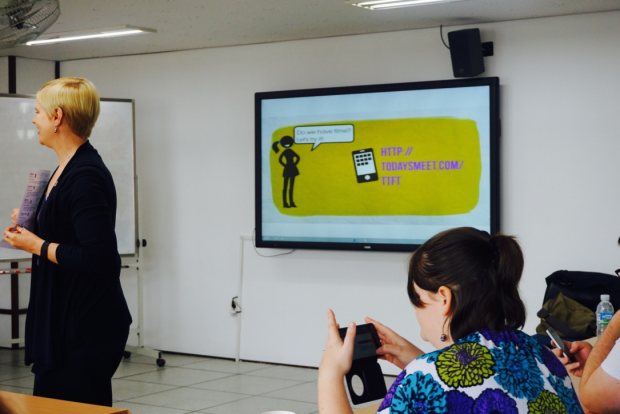
We all know that the internet is a major resource for information (and other things) on just about anything one can think of. With my Facebook feed continually updating with news and entertainment from around the world, it’s easy to get lost in the shuffle of all that’s out there. This is also true for the resources available to teachers, new and old. With so many options to get and keep students engaged on learning targets, new teachers might have a hard time figuring out which tools are most effective in the EFL classroom. Well, presenter Lindsay Herron made that much easier on us with her presentations “Ten Tech Tools Teachers Should Know About” at the quarterly workshop in March 28, 2015.
Lindsay Herron has been a visiting professor at Gwangju National University of Education since 2008. Prior to that, she taught for three years on a Fulbright grant at Seogwipo High School in Jeju-do. She has a master’s degree in language education from Indiana University-Bloomington, a master’s incinema studies from New York University, bachelor’s degrees in English and psychology from Swarthmore College, a CELTA, and the CELTA YL Extension. She is also the coordinator for the Multimedia & CALL SIG (Multimedia and Computer-Assisted Language Learning Special Interest Group).
The ten tech. tools teachers should know about were: Google Drive, Class DOJO, Today’s Meet, QR Stuff, Puzzle Maker, Padlet, Vocaroo, Amara, Readlists, and My Brainshark respectively. From the very beginning, attendees were scanning QR Codes from their smart phones and accessing all these fun sites that are sure to get your students (EFL learners of all ages) engaged.
While I’m familiar with Google Drive and being able to create, save and share documents, I wasn’t familiar with creating surveys or the possibility of grading quizzes or creating polls. Class DOJO is a fun behavior modification site where students earn points based on their behavior. Today’s MEET is a chat room where students can input answers or feedback to teacher dictated questions or discussion; also great for writing practice. QR Stuff is amazing because teachers can create QR Codes that can be scanned to reveal secret messages, audio recordings, videos, websites and more. I’m already planning on working this in for summer camp, 2015. Most teachers are familiar with Puzzle Maker; teachers input vocabulary words into a data bank, a few pictures, maybe and a word search is generated. Can also be used for crossword puzzles and matching activities. Padlet allows teachers to share ideas through an online sticky note board. Vocaroo allows teachers to easily upload voice recordings using a link. Amara, is great for finding or creating videos with subtitles. Readlists is useful for bundling online articles into a single e-book with the possibility of sharing with colleagues and students. Last, but not least, My Brainshark takes teaching outside of the classroom. Teachers can upload a students’ work and provide verbal feedback.
I’m so glad I didn’t miss this workshop as I’m already preparing on ways I can integrate some of these useful tech tools in the ESL classroom. However, if you’re interested in using these technologies or you would like Lindsay Herron to present this at your next workshop, contact her at, lnherron@gmail.com.


